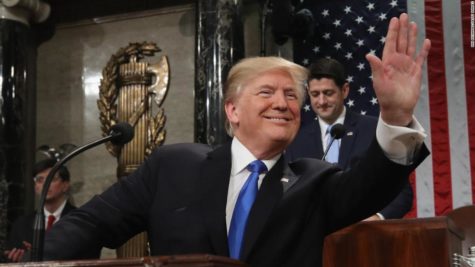State of the Union
Donald Trump presents the first State of the Union Address in his presidency
February 26, 2018

On Tuesday, January 30 President Donald Trump delivered his first official State of the Union address. He spoke confidently about the strength of the United States, despite the trials of 2017.
Several weeks after his address, Trump and his administration have already taken action to begin some of the projects that he outlined in his speech and there has been backlash from members of the opposing party.
One of the major issues that Trump discussed was our foreign relationships and military power. Our lasting conflicts with terrorist groups, such as ISIS, and North Korea have sparked controversy about how the United States should handle these issues.
In his address, President Trump said that he was planning to up the power of our military and our nuclear arsenal.
“We must modernize and rebuild our nuclear arsenal, hopefully never having to use it, but making it so strong and powerful that it will deter any acts of aggression,” Trump said about increasing military power.
Additionally, he mentioned that he would be putting more funding into the Department of Defense.
Since his address, the Pentagon has requested a boost in military funding for 2019. They have requested that Congress approve a $686 billion budget, which is one of the largest in United States history.
According to CNN, this is a “$80 billion increase [in the Department of Defense’s budget] from 2017.”
Besides the military, President Trump emphasized his desire to secure our borders and reform the path to citizenship for immigrants. He outlined a four pillar plan for legal immigrants, which he hopes will rule out illegal immigrants and make the path to citizenship more efficient.
Trump’s proposal was meant to strike a balance between the demands of the Republicans and Democrats. He vowed to secure the borders by increasing the number of border patrol agents and by funding the construction of a border wall, which appeals to the Republicans. On the other hand, Trump’s “Four Pillar Plan” was meant to provide an adequate pathway to citizenship for DACA recipients, which the Democrats are largely in favor of.
DACA, Deferred Action for Childhood Arrivals, was established in 2012 under President Obama and it was meant to give illegal immigrants who entered the country as minors the chance to be eligible for a work permit and escape deportation for two years.
This policy has been hotly debated over the last several months, as the Trump administration has planned to put an end to DACA. However, Trump acknowledged the Democrat’s opinions through his proposal of the “Four Pillar Plan”.
In response to this, there has been debate in both the House of Representatives and the Senate about these proposed plans.
Nancy Pelosi, House Minority Leader and Democrat, recently stood in front of the House of Representatives and delivered an eight hour speech in which she defended DACA.
According to the Washington Post, “Her speech [has been] ranked as the longest given by a member of the House of Representatives in at least a century, possibly ever.”
Since then, there has been increased debate in Congress about immigration policies and the solutions that Trump delivered in his address.
Lastly, President Trump called on Congress to produce a bill that will put $1.5 trillion into rebuild America’s infrastructure.
“We built the Empire State Building in just 1 year — is it not a disgrace that it can now take 10 years just to get a permit approved for a simple road?” said Trump about the U.S.’s crumbling infrastructure.
After making this proposal, Congress have been trying to come to an agreement on an infrastructure plan. Bills have yet to be passed on this issue, but there have been proposals that might aid in the funding of his plan.
While there were many other issues that Trump discussed in his first State of the Union address, these are several of the most noteworthy and have caused the people and the government to take action for solutions.














